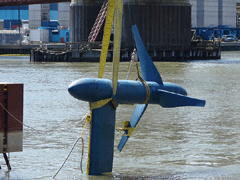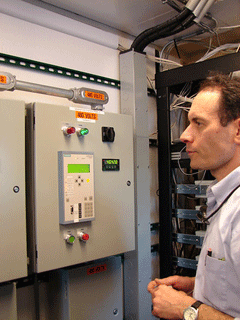Riding the Tide
Air Date: Week of May 11, 2007

Verdant Power turbines being lowered into New York's East River as part of the Roosevelt Island Tidal Energy (RITE) Project. (Photo: Kris Unger)
Tidal currents from New York City’s East River are being used for electrical power. The energy is generated by underwater turbines as part of a demonstration project by Verdant Power. The company must show that the turbines won’t hurt migrating fish. As WNYC’s Beth Fertig reports, Verdant is one of several companies experimenting with tidal power in coastal regions of the country.
Transcript
CURWOOD: So, how about some good news about the challenge of climate change. Well there’s now an experiment in New York City to make electric power from a way you might not expect. It seems to be clean, and certainly has no climate changing gases, no ugly towers, or waste products. From the East River of New York City, Beth Fertig of member station WNYC has our report.
[RIVER WATER AT SHORE]
FERTIG: The East River is actually a tidal strait that flows along the East Coast of Manhattan, connecting Long Island Sound to New York Harbor. For some engineers, it’s not just a body of water but a powerful, potential source of energy.
CORREN: You have first of all a big fast river, you have to have fast currents, that’s what it’s all about, it’s embedded in civilization it’s not in the middle of arctic or something.
FERTIG: Dean Corren is Director of Technology Development for Verdant Power. We’re standing on the shore of Roosevelt Island, a residential community which sits in the river between Manhattan and Queens.

Dean Corren, Verdant Power’s Director of Technology Development, monitoring the transmission of electricity from the turbines. (Photo: Kris Unger)
FERTIG: It’s off the coast of this skinny island that Corren and his engineers are preparing to operate a group of tidal turbines.
[OUTSIDE SOUNDS]
CORREN: All of us, our team together, has built six turbines to go underwater here that capture the kinetic energy of the flowing water without any dams. They’re sort of like underwater windmills. And as the tide goes in and the tide goes out, the flood and the ebb, they capture some of the energy and convert it directly to electricity.
FERTIG: Electricity that can be used to power homes and businesses. On a bright sunny morning, Corren’s team stands on the shoreline while a barge delivers equipment that can only be installed during a slack tide.
CORREN: When the tide stops we gotta go. We can only do this stuff when water’s not running.
FERTIG: As Corren climbs down a ladder to the water’s edge, a huge crane takes four white rectangular frames off the barge and gently lays them in the water.
[HONK]
FERTIG: Each frame is about 20 feet long and contains three ultrasonic devices. They were especially designed for observing fish. Verdant can’t get a permit to operate until it proves to state and federal agencies that its turbines won’t hurt migrating wildlife. But Corren predicts that shouldn’t be a problem.

(Photo: Kris Unger)
FERTIG: And those tests are just beginning.
[CONTROL ROOM SOUND]
FERTIG: In a former shipping container that’s been turned into a control room, Verdant has spent several months studying the habits of East River wildlife. Analyst Hannah Abend uses her computer to look at underwater images captured by a different sonar device last year.
ABEND: So I’m going to show you an example of what a school of fish looked like before the turbine was actually in the water.
FERTIG: Verdant conducted a test run with a single turbine at the beginning of this year. Abend says she saw a few herrings, a striped bass and a cormorant. But they stayed away from the turbine – which was located about a quarter of the way out in the river.
ABEND: One of the interesting things I’ve discovered from analyzing all of this data is that generally the fish hang around the rocks; they hang around during slack tide when the turbine isn’t moving at all because the water is really quiet. They don’t like fast currents. They also don’t hang out that far they like the safety of the rocks. And so this bodes very well for having turbines in river environments like this.
FERTIG: The test turbine operated for more than a month, until engineers discovered a problem with its blade. In that time, Verdant says it generated about 8000 kilowatt hours during active tide cycles – enough to power a couple of homes for a year. The electricity was used by the Gristedes supermarket on Roosevelt Island – proving the East River could generate power. Verdant’s founders compare that to the flight of the Kitty Hawk because tidal power is still in its infancy.

Verdant Power turbines being lowered into New York's East River as part of the Roosevelt Island Tidal Energy (RITE) Project. (Photo: Kris Unger)
THRESHER: It’s a lot easier to do things on land than it is in the water.
The turbines may look like windmills. But they’re actually much more complicated, says Robert Thresher, who has studied tidal power as director of the National Wind and Technology Center in Denver, Colorado.
THRESHER: You have to get out there, you have to have boats, you have to have crews, if you’re going to put a foundation in, you can’t just dig a hole with a back hoe and pour a foundation. And then if you’re in estuary you have salt water, which is a corrosion issue that you just don’t have with wind turbines.
FERTIG: That’s not to say it isn’t possible. Thresher is a big proponent of alternative sources of energy, and he says tidal power has great potential. Unlike wind, tides are predictable because they come in cycles. It’s just going to take more research… and more money to resolve questions of environmental impact and commercial viability.
THRESHER: Cause people haven’t done it before, the permitting’s not worked out. When people are permitting they don’t know what to worry about so they worry about everything.
FERTIG: The Federal Energy Regulatory Commission says about there are about fifty applications for permits by companies experimenting with tidal power, from Washington State to Florida and Maine.
[OUTDOOR SOUNDS]
FERTIG: Verdant says it’s spending more than six million dollars on the East River project. A third of that money alone is going toward the fish monitoring, and other regulatory and permitting issues. If they can pass the initial hurdles, Hannah Abend and her coworkers envision a day when a couple of hundred turbines off the coast of Roosevelt Island could generate enough power for 5000 homes. And because they’re underwater, she says there’s little fear of neighborhood opposition.
ABEND: A neat way to look at it would be this is like the quietest electric plant ever or power plant ever because you’ll never see them and if everything is working well, you’ll just get power from the current.
FERTIG: Verdant’s new turbines are being tested just in time for bass migration. The company is also applying for permits to test in Long Island Sound. For Living on Earth I’m Beth Fertig in New York.
Links
Verdant Power on the Roosevelt Island Tidal Energy (RITE) Project
Living on Earth wants to hear from you!
Living on Earth
62 Calef Highway, Suite 212
Lee, NH 03861
Telephone: 617-287-4121
E-mail: comments@loe.org
Newsletter [Click here]
Donate to Living on Earth!
Living on Earth is an independent media program and relies entirely on contributions from listeners and institutions supporting public service. Please donate now to preserve an independent environmental voice.
NewsletterLiving on Earth offers a weekly delivery of the show's rundown to your mailbox. Sign up for our newsletter today!
 Sailors For The Sea: Be the change you want to sea.
Sailors For The Sea: Be the change you want to sea.
 The Grantham Foundation for the Protection of the Environment: Committed to protecting and improving the health of the global environment.
The Grantham Foundation for the Protection of the Environment: Committed to protecting and improving the health of the global environment.
 Contribute to Living on Earth and receive, as our gift to you, an archival print of one of Mark Seth Lender's extraordinary wildlife photographs. Follow the link to see Mark's current collection of photographs.
Contribute to Living on Earth and receive, as our gift to you, an archival print of one of Mark Seth Lender's extraordinary wildlife photographs. Follow the link to see Mark's current collection of photographs.
 Buy a signed copy of Mark Seth Lender's book Smeagull the Seagull & support Living on Earth
Buy a signed copy of Mark Seth Lender's book Smeagull the Seagull & support Living on Earth

